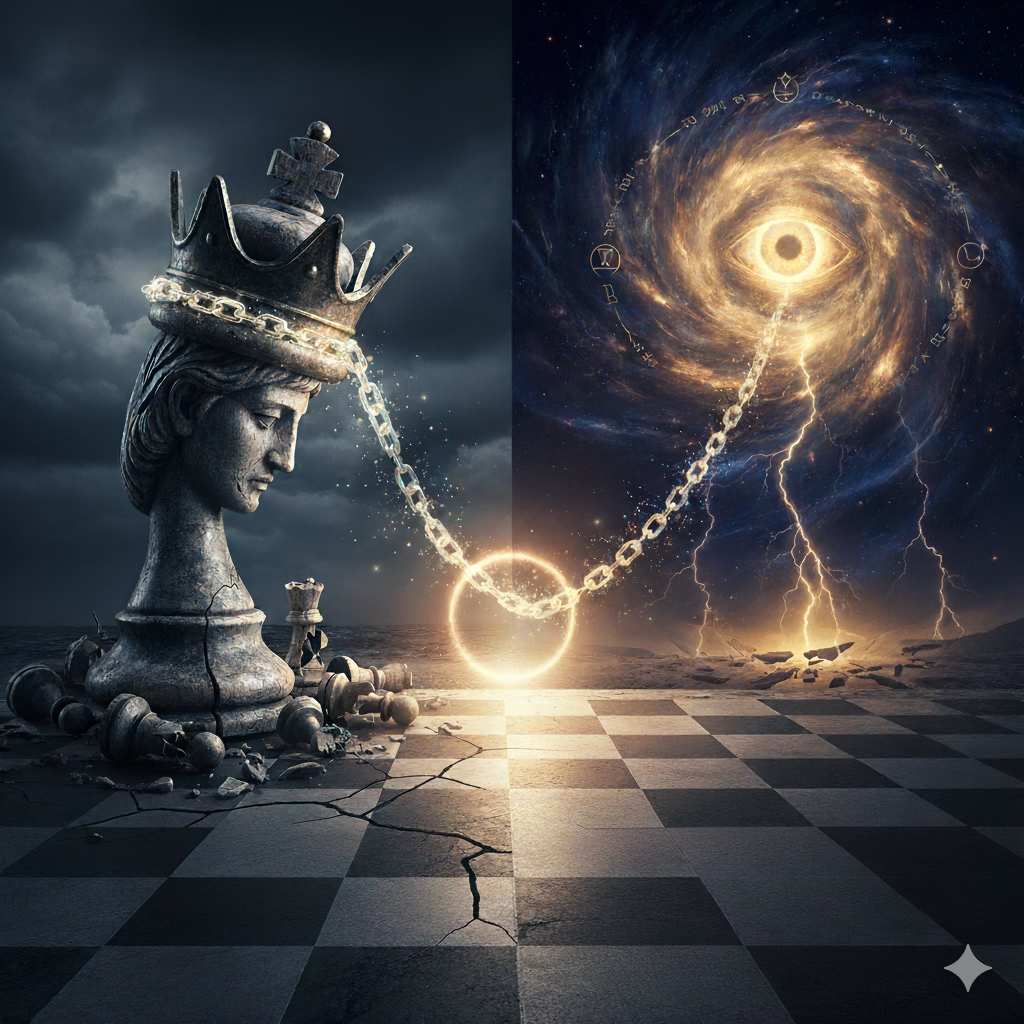“Simplicity is the ultimate sophistication.” – Leonardo da Vinci
In our increasingly complex world, we often search for sophisticated solutions to stubborn problems. Whether we’re contemplating our next move on a chessboard, lining up a putt on the 18th green, or staring at a frozen computer screen, we instinctively reach for complex strategies. But there’s a profound wisdom in the humble restart—the art of beginning again. Sometimes the most sophisticated response to complexity is the simplest one: turning it off and on again.
The Chess Master’s Paradox: Complexity Born from Simple Rules
Chess, often called the “game of kings,” presents us with a beautiful paradox. Its rules can be learned in minutes—pawns move forward, rooks move straight, bishops diagonal, and so forth. Yet from these simple foundations emerges a complexity so vast that even the most powerful computers struggle to master it completely.
The grandmaster doesn’t win by calculating every possible variation (an impossible task), but by recognizing patterns, understanding principles, and making seemingly simple moves that carry profound strategic weight. As chess legend José Capablanca once said, “I see only one move ahead, but it is always the correct one.”
This mirrors the philosophy of restart in technology and life. The most elegant solutions don’t necessarily involve the most sophisticated algorithms or the most complex strategies. Sometimes, the most profound move is the simplest one: beginning again.
// The simplest solution is often the best solution
function fixComputer() {
return restart();
}
The Knight’s Move: Sometimes the Indirect Path is the Direct One
In chess, the knight moves in an L-shape—seemingly the most convoluted piece on the board. Yet this apparent complexity serves a simple purpose: it can jump over other pieces and reach squares that no other piece can access directly. Sometimes, the most elegant solution requires what appears to be an indirect approach.
Much like how we solve computer problems. Your video won’t play? Don’t dive into codec configurations and driver compatibility matrices. Just restart the browser. Your Wi-Fi is acting up? Skip the network diagnostics. Restart the router. The knight’s wisdom: sometimes the most circuitous path is actually the straight line.
Checkers: The Beauty of Democratic Simplicity
If chess is the aristocrat of board games, then checkers is its egalitarian cousin. Every piece starts equal, moves the same way, and has the same potential for greatness. There are no queens, no knights with their fancy L-shaped moves—just simple, honest pieces moving diagonally forward until they reach the promised land of “kinghood.”
Yet within this democratic simplicity lies profound strategic depth. A checkers master understands that power comes not from having superior pieces, but from superior positioning and timing. Every move matters because every piece matters.
In the world of technology, this translates to the principle that you don’t need the most expensive, feature-laden solution to solve a problem. Sometimes the $5 cable works just as well as the $50 “premium” one. Sometimes the basic plan is all you need. Sometimes—and this might shock you—restarting your computer works better than purchasing a new graphics card.
The King Me Moment: When Simple Things Become Powerful
In checkers, when a humble piece reaches the far end of the board, it becomes a king—gaining the power to move backward as well as forward. This transformation isn’t gradual; it’s instantaneous and complete. One moment you’re a regular piece, the next you’re royalty.
This mirrors how simple solutions can have profound effects. When you restart your computer, you’re not just clearing the RAM—you’re ascending to a temporary digital kinghood where all processes are fresh, all connections are clean, and for a brief, beautiful moment, everything works exactly as it was designed to.
“Have you tried turning it off and on again? No seriously, have you? Because I’m not joking. That’s literally the solution to 90% of your problems.” — Unknown IT Support Technician
Golf: The Zen of Doing Less to Achieve More
Golf presents us with perhaps the purest expression of the restart philosophy. The objective couldn’t be clearer: get a small ball into a small hole using the fewest strokes possible. The tools are simple: clubs and a ball. The technique appears straightforward: hit the ball toward the hole.
Yet golf humbles even the most accomplished athletes because it demands a paradoxical mindset: the harder you try, the worse you get. The secret to golf lies in controlled relaxation, in trusting the swing you’ve practiced, in understanding that sometimes a gentle 7-iron is more effective than a mighty driver.
The Restart Swing: When Everything Goes Wrong, Go Back to Basics
Every golfer knows the feeling: you’re having a terrible round, nothing is going right, and every shot seems to make things worse. The temptation is to try harder, swing faster, change your grip, adjust your stance, buy new clubs. But seasoned golfers know better. They step back, take a deep breath, and return to their most basic, fundamental swing.
This is the golf equivalent of restarting your computer. When everything goes wrong with technology, we often try increasingly complex solutions: we update drivers, modify registry settings, install new software, consult online forums, and perform digital rain dances. But the golf philosophy suggests a different approach: stop, breathe, and return to the fundamentals.
# The golf swing of IT support
sudo reboot
# Sometimes that's all you need
# No complex commands required
# No advanced troubleshooting
# Just... start over
The Hole-in-One Philosophy: Perfection Through Simplicity
A hole-in-one is golf’s ultimate achievement—not because it requires the most skill (though it certainly requires some), but because it represents the perfect marriage of preparation, execution, and a little bit of luck. It’s one swing, perfectly executed, that achieves what might otherwise take multiple attempts.
In technology, the “hole-in-one” is that moment when the simplest solution works perfectly the first time. Your internet is down, you restart the router, and suddenly everything works flawlessly. Your phone is frozen, you hold down the power button for ten seconds, and it springs back to life. It’s not glamorous, it’s not sophisticated, but it’s perfect.
The Great Restart: Technology’s Universal Solvent
There’s something almost mystical about the restart. In a world where technology grows increasingly complex, where smartphones have more computing power than the computers that sent humans to the moon, where artificial intelligence can write poetry and diagnose diseases, the humble restart remains our most reliable problem-solving tool.
The Philosophy of the Fresh Start
Every restart is a small death and rebirth. The accumulated digital detritus of crashed processes, memory leaks, and confused states gets swept away, leaving a clean slate. It’s the technological equivalent of meditation—a return to a state of digital enlightenment where everything is as it should be.
Consider the poetry of the restart sequence:
- Shutdown: All processes cease, all connections close, all activity stops
- The Void: For a brief moment, complete digital silence
- Rebirth: The system awakens, fresh and clean, ready to begin again
# The philosophy of restart in code
def solve_problem():
if problem_exists():
restart()
return "Have you tried turning it off and on again?"
else:
return "Problem solved!"
# This function has approximately 90% success rate
# Better than most enterprise software solutions
The Restart Jokes: A Cultural Phenomenon
The restart has become such a fundamental part of our technological experience that it’s spawned an entire genre of humor:
- Classic IT Support: “Have you tried turning it off and on again?” (The battle cry of help desks worldwide)
- The Relationship Restart: “Maybe we should try turning our relationship off and on again.”
- The Life Restart: “I’m not having a midlife crisis, I’m just restarting my operating system.”
- The Cooking Restart: “This recipe isn’t working. Let me restart the oven.” (This doesn’t actually work, but we’ve all thought about it)
- The Pet Restart: “My cat is being weird. Have I tried turning it off and on again?” (Please don’t actually try this)
The Deeper Truth Behind the Restart Joke
But why is the restart joke so enduring and universally understood? Because it represents something profound about the human condition. We all wish we could restart when things go wrong—clear our mental cache, reload our emotional operating system, and begin fresh with all the bugs fixed and all the conflicts resolved.
The restart is the technological manifestation of our deepest desire: the chance to begin again.
Lessons from the Games: Applying Restart Wisdom to Life
What can chess, checkers, and golf teach us about the art of beginning again and living with restart wisdom?
From Chess: Pattern Recognition Over Calculation
Chess masters don’t succeed by calculating every possibility—they succeed by recognizing patterns and trusting their intuition built through experience. In life, this means:
- Trust your instincts when they’re based on experience
- Look for patterns in problems rather than trying to solve each instance individually
- Sometimes the obvious move is obvious for a good reason
From Checkers: Democratic Excellence
Checkers reminds us that you don’t need special advantages to succeed—you need good positioning and timing. In life, this translates to:
- Focus on your positioning (skills, relationships, opportunities) rather than lamenting what you lack
- Timing matters more than raw power
- Every move matters, no matter how small
From Golf: The Power of Letting Go
Golf teaches us that trying harder often produces worse results. The application to life:
- Sometimes the solution is to stop trying to solve the problem and just restart
- Perfection comes through practice of fundamentals, not through exotic techniques
- The target rarely moves; usually, the problem is with our approach
The Restart Metaphor: Beyond Technology
The restart concept extends far beyond technology. Consider these life “restarts”:
The Career Restart
Sometimes the best career move isn’t climbing the next rung on the ladder—it’s getting off the ladder entirely and finding a new one. The traditional advice says to persist, to work harder, to network more effectively. But sometimes the most elegant solution is to simply restart your career entirely.
The Relationship Restart
When relationships become cluttered with old arguments, accumulated resentments, and complex emotional baggage, sometimes the answer isn’t couples therapy or communication workshops. Sometimes it’s a simple restart: acknowledgment that you’re both different people than when you started, and a fresh beginning with clear expectations.
The Daily Restart
Every morning is a restart. Every meditation session is a restart. Every moment you choose to let go of what just happened and focus on what’s happening now is a restart.
“Confine yourself to the present.” — Marcus Aurelius
The Complexity Trap: When Simple Becomes Complicated
One of the great ironies of our time is how we’ve managed to make simple things complicated. Consider:
The Smart Home Paradox
We’ve created “smart” homes where it takes three different apps, two voice commands, and a PhD in network engineering to turn on a light bulb. Sometimes the old-fashioned wall switch was the superior technology—one action, immediate result, 100% reliability.
The Communication Complexity
We have more ways to communicate than ever before—email, text, Slack, Discord, WhatsApp, Teams, Zoom, FaceTime, carrier pigeons (okay, maybe not the last one). Yet somehow it’s become harder to actually communicate. Sometimes the most effective message is still the simplest: a phone call that starts with “Hi, how are you?”
The Entertainment Paradox
We have access to more entertainment than any generation in human history, yet we spend most of our time scrolling through options, unable to decide what to watch. The restart solution? Pick something randomly and watch it. The paradox of choice dissolves when you make choosing itself simple.
The Minimalist Movement: Restart as Liberation
The growing minimalist movement represents a cultural restart—a recognition that accumulation of stuff doesn’t lead to accumulation of happiness. Minimalists ask the radical question: “What if having less actually means having more?”
This connects directly to our restart philosophy. Just as restarting a computer clears away accumulated digital clutter, minimalism clears away accumulated physical and mental clutter. It’s about periodically restarting your relationship with possessions.
Digital Minimalism
Cal Newport’s concept of “digital minimalism” is essentially the restart philosophy applied to our relationship with technology. Instead of trying to manage the overwhelming complexity of notifications, apps, and digital distractions, digital minimalists regularly “restart” their digital lives by:
- Periodically deleting apps and starting fresh
- Taking regular breaks from social media (digital restarts)
- Choosing simpler tools over feature-rich alternatives
// Digital minimalism in practice
function digitalDetox() {
socialmedia.uninstall();
notifications.disable();
phone.putInDrawer();
return mentalClarity.activate();
}
// The most powerful technology is often no technology
The Science of Restart: Why Beginning Again Works
There’s actual science behind why the restart is so effective, both in technology and in life:
Cognitive Load Theory
Our brains, like computers, have limited processing capacity. When we accumulate too many “processes” running in the background—worries, distractions, unfinished tasks—our performance degrades. A mental restart (meditation, sleep, vacation) clears this cognitive cache.
The Zeigarnik Effect
Psychologist Bluma Zeigarnik discovered that we remember interrupted tasks better than completed ones. This means unfinished business creates mental background processes that consume cognitive resources. Restarting allows us to either complete these tasks or consciously choose to let them go.
Neuroplasticity and Fresh Starts
Neuroscience shows that our brains are constantly rewiring themselves. Every restart—whether it’s a new day, a new relationship, or a new project—is an opportunity for neural rewiring. The fresh start effect isn’t just psychological; it’s biological.
The Art of Knowing When to Restart
The wisdom isn’t just in knowing how to restart—it’s in knowing when to restart. Consider these scenarios:
When to Restart Your Computer
- Before the problem becomes critical
- When you notice performance degradation
- After installing new software
- When your spouse asks if you’ve tried turning it off and on again (this is a universal signal)
When to Restart Your Approach to a Problem
- When you’re trying the same failed solutions repeatedly
- When the solution has become more complex than the original problem
- When you find yourself googling “advanced troubleshooting techniques” for something that should be simple
When to Restart Your Life Direction
- When you’re moving fast in the wrong direction
- When your current path requires you to become someone you don’t want to be
- When success in your current trajectory feels like failure
“In pursuit of knowledge, every day something is added. In pursuit of wisdom, every day something is dropped.” — Lao Tzu
The Economics of Restart
There’s an economic principle hidden in the restart philosophy: the cost of overthinking often exceeds the cost of restarting. Consider:
Time Economics
- Troubleshooting time: 2 hours researching obscure solutions
- Restart time: 2 minutes
- Success rate: Approximately equal
Mental Economics
- Stress of complex solution: High cognitive load, potential for new problems
- Stress of restart: Minimal, familiar process
Opportunity Economics
- Time spent on complex solution: Could have been spent on productive work
- Time spent on restart: Essentially zero opportunity cost
Cultural Wisdom: The Universal Art of Beginning Again
The philosophy of restart isn’t new—the wisdom of beginning again appears across cultures and throughout history:
Eastern Philosophy
- Buddhism: The Middle Way avoids extremes
- Taoism: Wu wei—effortless action
- Zen: Direct pointing to the mind, bypassing complexity
Western Philosophy
- Stoicism: Focus on what you can control
- Minimalism: Less is more
- Pragmatism: What works is what matters
Indigenous Wisdom
- Native American: Take only what you need
- Aboriginal: Follow the songlines (simple, direct paths)
- African: Ubuntu—I am because we are (simple human connection)
The Paradox of Teaching Restart
Here’s the irony: I’ve written several thousand words to explain the philosophy of restart. This itself seems to violate the principle I’m advocating. The simplest explanation of restart wisdom would be:
When in doubt, restart.
But sometimes we need the complex explanation to understand the simple truth. Sometimes we need to think deeply about thinking less. Sometimes we need to write extensively about saying less.
This is the teacher’s paradox: using complexity to point toward simplicity, using many words to advocate for fewer words, using sophisticated reasoning to arrive at obvious conclusions.
Practical Applications: The Restart Toolkit
How can you apply restart philosophy immediately?
Daily Restart Practices
- Morning Restart: Begin each day as if yesterday’s problems don’t exist
- Midday Reset: Take a brief pause to clear mental cache
- Evening Shutdown: Consciously end the day and release its concerns
Problem-Solving Restart Protocol
- Identify the problem
- Ask: “What’s the simplest possible solution?”
- Try the simple solution first
- If it doesn’t work, restart the problem-solving process
- Resist the urge to immediately escalate complexity
Relationship Restart Methods
- Daily: Assume positive intent
- Weekly: Have a fresh conversation about a recurring issue
- Monthly: Restart expectations and agreements
- Annually: Restart the relationship itself—who are you both now?
Career Restart Indicators
- You’re solving problems that shouldn’t exist
- Your job requires you to make simple things complicated
- You spend more time managing tools than using them
- You can’t explain what you do in simple terms
The Future of Restart
As technology becomes more complex, the value of restart wisdom increases exponentially. We’re approaching what some call “peak complexity”—the point where additional features subtract value rather than add it.
The future belongs to those who can:
- Cut through complexity to find simple solutions
- Restart gracefully when current approaches aren’t working
- Recognize when good enough is perfect
- Choose simple tools over complicated ones
AI and the Return to Restart Simplicity
Ironically, artificial intelligence—one of the most complex technologies ever created—is making interaction with technology simpler. Instead of learning complex interfaces, we’re returning to the most natural interface of all: conversation.
“Turn off the lights” is simpler than navigating through three menus and two sub-screens. AI is the restart that takes us back to intuitive interaction.
Conclusion: The Profound Wisdom of Starting Over
In chess, the most elegant games often involve simple, classical moves executed with perfect timing. In checkers, victory comes to those who understand that every piece matters and that simple, consistent progress trumps dramatic gestures. In golf, the perfect swing feels effortless because it embodies years of practice distilled into a moment of pure simplicity.
And in technology—in life—the restart remains our most reliable solution because it embodies the deepest wisdom: sometimes the most sophisticated response to complexity is to begin again.
The philosophy of restart isn’t about avoiding complexity or dumbing things down. It’s about recognizing when to persist and when to start fresh. It’s about having the wisdom to know that sometimes progress comes through regression—taking a step back to move forward more effectively.
Most importantly, it’s about remembering that in a world that profits from your confusion, your ability to find simple solutions is a form of rebellion. Every time you solve a complex problem with a simple restart, you’re asserting that clarity is possible, that not everything needs to be complicated, and that sometimes—just sometimes—the obvious answer is obvious because it’s correct.
“I would not give a fig for the simplicity that lies on this side of complexity, but I would give my life for the simplicity that lies on the far side of complexity.” – Oliver Wendell Holmes
So the next time you’re facing a complicated problem—whether it’s a frozen computer, a difficult relationship, or a life that feels too complex to manage—remember the wisdom of the restart. Sometimes the most profound solution is also the simplest one:
Turn it off. Count to ten. Turn it back on.
And trust that sometimes, beginning again is the most sophisticated thing you can do.
Have you tried restarting your perspective? Because that’s literally the solution to 90% of life’s problems.
# The ultimate life command
sudo reboot --life
# Warning: This command may require courage to execute
# Results may vary, but satisfaction guaranteed
This article is part of the Restart Project—an exploration of how elegant solutions emerge from simple principles. To see this philosophy in action, visit our 🌐 collection of restart commands across 50+ programming languages, where the most powerful operation is often the simplest one: turning it off and on again.





